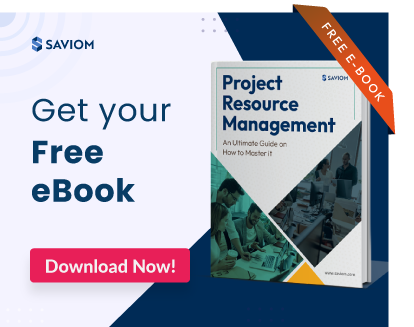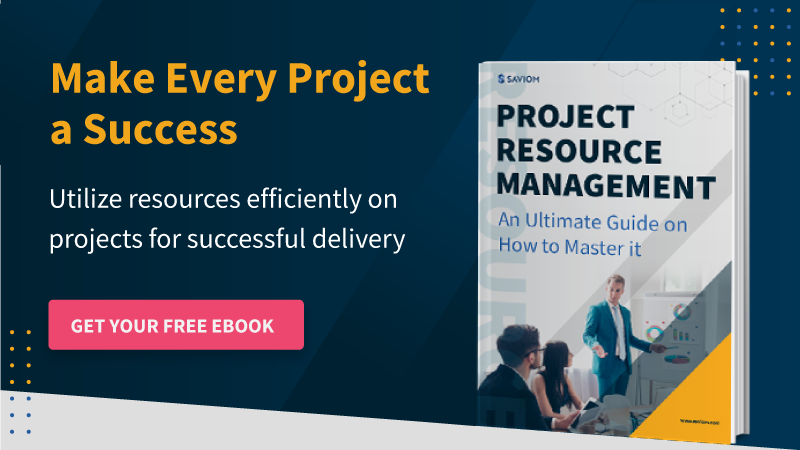In the present business scenario, projects must be performed and delivered under specific constraints. These constraints are cost, time, scope, etc. Likewise, resources are one such constraint that project managers need to manage effectively.
Resources are the driving force behind the success of the project. Therefore, one must ensure that you have the right resources for your project. And for that, you should have an efficient resource evaluation process.
For example, let’s assume that you have been assigned a project, which will begin after six months. The stakeholders have already approved the project duration and budget. Now all you have to do is find the right resources for your project.
When it comes to finding resources, you’ll have questions such as:
- How can I assess the type of resources required?
- How many resources will I require for the project?
- What are the skills that I should look for?
- Do I have sufficient resource capacity?
Proper resource estimation can answer all these questions. This blog will cover all the aspects of resource estimation. Besides, it will also provide a way to future-proof the workforce.
What is resource estimation?
Resource estimation is the technique of assessing the type and number of resources required for an upcoming project. For example, these resources could be human labor, materials, tools, equipment, supplies, machinery, etc.
Let’s suppose that there is a construction project coming up. For that, you must ascertain the number of civil engineers, architects, construction workers, and other labor that will be required. In addition, you should also estimate the number and grading of equipment, machinery, tools, and other necessary material for the construction project.
This phenomenon of predetermining the quantity and quality of resources is known as resource estimation.
Read More: What is Resource Forecasting? An Ultimate Guide for Project Managers
What is the importance of resource estimation in project management?
Since resources are the ones that make the project successful, their productivity determines the timely delivery of the project. For instance, poorly executed resource estimation will lead to improper resource allocation. It will, in turn, result in suboptimal resource productivity. Thus, leading to compromised results, client dissatisfaction, and project overruns.
Practical resource estimation can lead to the identification of the resource requirements and resource breakdown structure. Moreover, it guarantees that enough resources are procured beforehand.
Ways to estimate resources
There are five methods for estimating resources. Here is a brief description of all the methods:
Expert judgment
Expert judgment helps when you are stuck at some point and need guidance or advice. It is a way of getting help from seniors who have previous experience in similar projects. The expertise can be based on an individual’s training, career experience, knowledge of the product, etc.
You can take this type of guidance from a team member, senior project managers, stakeholders, consultants, SMEs, etc. It can help you understand the number of resources, duration, time, and risks involved in the previous projects. Based on that, you can ascertain the resources and the other constraints in your project.
Analogous estimating
Analogous estimation is done when you don’t have much input on the current project. Thus, you have to research previous project documents, plans, and estimates and find the quantity and quality of resources required for those projects. Following that, you can base your calculations on the upcoming project.
Although this technique takes less time, it is not accurate. Therefore, this method is best suited when your project is precisely similar to the previous project. Moreover, if the historical estimations were incorrect, the analogous estimate for the upcoming project will also be flawed.
Read More: 5 Best Practices for Capacity Management
Parametric estimating
It is an estimation method where statistical techniques are used to calculate the cost, duration, or resources based on earlier project data. You will put the parameters into a spreadsheet or software that uses data from similar past projects to calculate estimates.
For instance, let’s assume that a construction worker needs 2 hours to dig 100 ft of land using certain equipment. Based on that knowledge, you can estimate that for digging up 1000 ft of land, the worker will need 20 hours to complete this task. Thus, parametric estimating methods give more accurate results than analogous estimation or expert judgment.
Bottom-up estimating
The bottom-up method of resource estimation involves analysis done at a granular level. The WBS has four levels: top-level, controls account, work packages, and activities level. In this form of assessment, a calculation is done at the activity or work packages level. Then, these estimations are added up to obtain the total estimate.
For example, let’s assume you need different resources for various activities. First, you will split the tasks and calculate the resources required for each task. Following that, you will add the number of resources and their costs to get the total estimate—the smaller and more detailed the task, the greater the accuracy of this technique.
Read More: 7 Powerful Benefits of Resource Scheduling for Project Managers
Alternative analysis
As the name suggests, alternative analysis means figuring out alternate types of resources, skill sets, equipment, etc. Based on that, you can select the right project team considering constraints such as cost, time, and quality associated with each of them.
Moreover, with alternative analysis, you can consider different options on how to allocate resources. For instance, you can change the type of resources used or reassess the number of resources. Besides, you can select the best way to perform a task. Since there are multiple ways to complete a task, alternative analysis lets you find the best possible way.
Published estimated data
Project managers can gather resource information from published reports such as trade journals, websites, etc. You can estimate the resources required from reading the magazines of similar completed projects. That way, you can get an idea of what type and number of resources are needed for a project of similar nature. Besides, you will also get a glimpse of the resource costs and the duration.
Read More: Eight Signs That You Need Better Resource Scheduling
Steps involved in resource estimation
One can deliver every project successfully with efficient resource utilization. To allocate the right resources, you must have the correct resource estimation process. Here is a detailed analysis of the process that one should follow for practical resource estimation:
Evaluate WBS and activity list
The WBS is the complete step-wise display of the whole project. It is a hierarchical structure that consists of the final deliverable, activities, milestones, and so on. Therefore, as a project manager, you must have a complete understanding of the WBS.
For estimating resources, you should know about all the activities involved. Since activities are at the lowest level in the WBS, you will have to ascertain the number and quality of resources based on the activities. Thus, you have to dissect every activity and create a proper evaluation of that level.
Estimate the resource requirements
After you have evaluated the activity list, you must define the resource requirements. First, you should identify the type, skills, experience, and quantity of resources. Apart from human labor, you should also determine the requirements for equipment, tools, machinery, and so on. For instance, in a construction project, the human skills required will be architects, engineers, surveyors, etc. Additionally, the non-human resources will be cranes, cement, bricks, stones, etc.
Once you have identified the resource requirements, you must inform the concerned stakeholders and take their opinions. Following that, you can indicate the resource managers regarding the requirements.
Read More: What is Resource Planning, and Why is it Important in Project Management?
Provide a heads-up to the resource manager
As the resource manager is in charge of the resources, you must provide him/her with the necessary resource details. That way, he/she can select the best resources for the project. Then, based on the project priority, you can inform the resource manager about the requirements.
Modern resource management solutions allow project managers to send resource requests directly to the resource manager. This request reaches the inbox of the resource manager in charge, who starts resource planning. The whole process is documented and remains auditable. Thus, it eliminates any process-related confusion or conflicts.
Identify resource availability
After getting the heads-up on the resource requirements, the resource manager will calculate the capacity of the resources as per the project demand. Then, he/she will assess the resource pool and determine if all the necessary resources are available within the enterprise.
A resource management software provides 360-degree visibility of the resource pool throughout the enterprise. A resource manager can tap into the utilization of the resources and get a glimpse of the workload. That way, he/she can identify the availability of the required resources.
Read More: Understanding Resource Availability within Project Management
Identify shortfall or excess of resources
Once the resource manager determines the availability of the resources, he/she can identify the shortfalls or excesses of the concerned resources.
The capacity vs. demand report gathers data from multiple perspectives, i.e., role, department, team, location, skills, etc. Thus, it helps in identifying the short or long-term shortfall/excess of resources ahead of time. Based on that, the resource managers can bridge the gap with appropriate treatments such as re-training current employees or hiring new resources.
Hire or retrain resources as needed
After identifying the excesses or shortages, the resource manager can apply appropriate treatments to bridge the capacity gap. For instance, if there is an excess of resources, training or reskilling can be exercised to bridge the gap. Also, if the resources match the minimum qualification criteria, they can be given on-the-job training, thus increasing billability.
Besides, depending upon the project’s duration and nature, managers can effectively take appropriate resourcing measures.
Read More: What is Resource Capacity Planning? An Ultimate Guide for Every Project Manager
Explore contingent resources for short-term opportunities
Instead of hiring permanent employees, resource managers can hire contingent resources. They are contractual workers, freelancers, temp workers, etc. They can be employed only for a specific project duration and then laid off after the job. Moreover, this on-demand workforce requires no lead time and involves no overhead costs.
Besides, a resource management solution also helps find cost-effective global resources. That way, resource managers can assign resources at lower costs without compromising quality.
Conclusion
Resource estimation not only helps in determining the resource requirements for pipeline projects. But it also helps in identifying the resource costs, project duration, and risks associated with the projects.
In a nutshell, resource estimation can help project managers calculate different aspects of future projects.
SAVIOM Solution
SAVIOM has over 20 years of experience helping multinational clients manage their resources efficiently and effectively. With over 20 years of experience, this Australian-based MNC has a global presence across 50 countries and has helped 100+ clients meet their specific business goals. Saviom also provides tools for project portfolio management, professional service automation, and workforce planning software. So, SAVIOM can help your business to establish an efficient system geared towards your specific business challenges.













